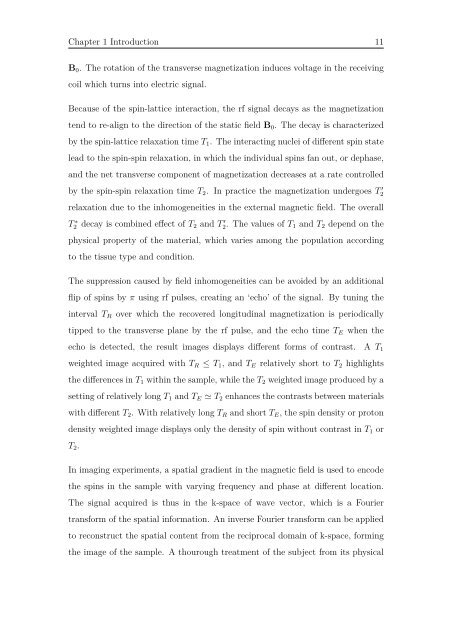Docteur de l'université Automatic Segmentation and Shape Analysis ...
Docteur de l'université Automatic Segmentation and Shape Analysis ...
Docteur de l'université Automatic Segmentation and Shape Analysis ...
You also want an ePaper? Increase the reach of your titles
YUMPU automatically turns print PDFs into web optimized ePapers that Google loves.
Chapter 1 Introduction 11<br />
B0. The rotation of the transverse magnetization induces voltage in the receiving<br />
coil which turns into electric signal.<br />
Because of the spin-lattice interaction, the rf signal <strong>de</strong>cays as the magnetization<br />
tend to re-align to the direction of the static field B0. The <strong>de</strong>cay is characterized<br />
by the spin-lattice relaxation time T1. The interacting nuclei of different spin state<br />
lead to the spin-spin relaxation, in which the individual spins fan out, or <strong>de</strong>phase,<br />
<strong>and</strong> the net transverse component of magnetization <strong>de</strong>creases at a rate controlled<br />
by the spin-spin relaxation time T2. In practice the magnetization un<strong>de</strong>rgoes T ′ 2<br />
relaxation due to the inhomogeneities in the external magnetic field. The overall<br />
T ∗ 2 <strong>de</strong>cay is combined effect of T2 <strong>and</strong> T ′ 2. The values of T1 <strong>and</strong> T2 <strong>de</strong>pend on the<br />
physical property of the material, which varies among the population according<br />
to the tissue type <strong>and</strong> condition.<br />
The suppression caused by field inhomogeneities can be avoi<strong>de</strong>d by an additional<br />
flip of spins by π using rf pulses, creating an ‘echo’ of the signal. By tuning the<br />
interval TR over which the recovered longitudinal magnetization is periodically<br />
tipped to the transverse plane by the rf pulse, <strong>and</strong> the echo time TE when the<br />
echo is <strong>de</strong>tected, the result images displays different forms of contrast. A T1<br />
weighted image acquired with TR ≤ T1, <strong>and</strong> TE relatively short to T2 highlights<br />
the differences in T1 within the sample, while the T2 weighted image produced by a<br />
setting of relatively long T1 <strong>and</strong> TE T2 enhances the contrasts between materials<br />
with different T2. With relatively long TR <strong>and</strong> short TE, the spin <strong>de</strong>nsity or proton<br />
<strong>de</strong>nsity weighted image displays only the <strong>de</strong>nsity of spin without contrast in T1 or<br />
T2.<br />
In imaging experiments, a spatial gradient in the magnetic field is used to enco<strong>de</strong><br />
the spins in the sample with varying frequency <strong>and</strong> phase at different location.<br />
The signal acquired is thus in the k-space of wave vector, which is a Fourier<br />
transform of the spatial information. An inverse Fourier transform can be applied<br />
to reconstruct the spatial content from the reciprocal domain of k-space, forming<br />
the image of the sample. A thourough treatment of the subject from its physical

















